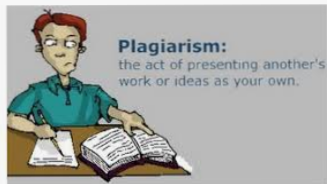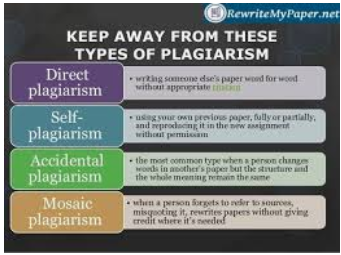
Plagiarism is the representation of another author's language, thoughts, ideas, or expressions as one's own original work. In educational contexts, there are differing definitions of plagiarism depending on the institution.
There are different types of plagiarism and all are serious violations of academic honesty.
We have defined the most common types below and have provided links to examples.

DIRECT PLAGIARISM
Direct plagiarism is the word-for-word transcription of a section of someone else’s work, without attribution and without quotation marks.
The deliberate plagiarism of someone else's work is unethical, academically dishonest, and grounds for disciplinary actions, including expulsion.
SELF PLAGIARISM
Self-plagiarism occurs when a student submits his or her own previous work, or mixes parts of previous works, without permission from all professors involved.
It would be unacceptable to incorporate part of a term paper you wrote in high school into a paper assigned in a college course, Self-plagiarism also applies to submitting the same piece of work for assignments in different classes without previous permission from both professors.
MOSAIC PLAGIARISM
Mosaic Plagiarism occurs when a student borrows phrases from a source without using quotation marks, or finds synonyms for the author’s language while keeping to the same general structure and meaning of the original. Sometimes called “patch writing,” this kind of paraphrasing, whether intentional or not, is academically dishonest and punishable – even if you footnote your source.
ACCIDENTAL PLAGIARISM
Accidental plagiarism occurs when a person neglects to cite their sources, or misquotes their sources, or unintentionally paraphrases a source by using similar words, groups of words, and/or sentence structure without attribution. Students must learn how to cite their sources and to take careful and accurate notes when doing research.
The Note-Taking section on the Avoiding Plagiarism, lack of intent does not absolve the student of responsibility for plagiarism. Cases of accidental plagiarism are taken as seriously as any other plagiarism and are subject to the same range of consequences as other types of plagiarism.
That all of my work on achievement3, i hope i'm now okey with this of my task.
Please this content is all about the steemit content etiquette and plagiarism is highly prohibited! The content is about content etiquette and based on what you have written here, i see you have no idea of what the achievement 3 is talking about, because your content has 92% copied content.
please, it will be better if you go through your content again, or better still bring up another content of your own that is regarding to this topic and at the end of the content, add the below text as seen on the image below.
Thank you.
Downvoting a post can decrease pending rewards and make it less visible. Common reasons:
Submit